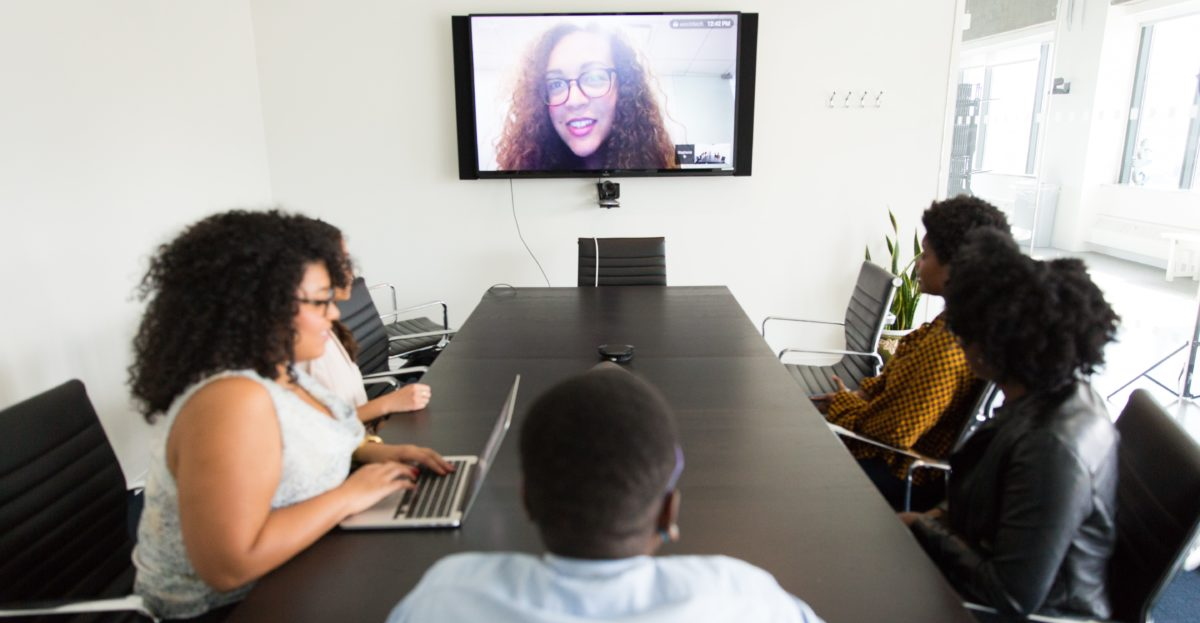
Considerations and Best Practices for Running Hybrid Meetings
The COVID-19 pandemic forced many organizations to have far more employees working remotely than ever before. How many will continue to do so will vary based on many factors: employee sentiment, perceived or real productivity gains or losses, cost savings, new infection surges that create health emergencies, and more.
The Institute for Corporate Productivity (i4cp) has created an infographic, the Who’s Who of Flexible and Hybrid Work Arrangements, that illustrates the range of approaches companies are taking regarding work models and where certain types of work will get done. Some organizations, such as Twitter, Zillow, and others have announced that their shift to mostly remote work will be permanent, while far more organizations are committing to varied levels of flexible or hybrid work arrangements (e.g., two or three days per week in a traditional office) with the caveat that things are fluid and may need to be revisited.
It seems likely that many organizations will soon (if they aren’t already) be holding more hybrid meetings—that is, meetings in which some employees are face-to-face in an office or other traditional worksite, and others are dialed in via Zoom, WebEx, Teams, or other platforms. Hybrid meetings are not new; many organizations have been holding them for the past two decades. But few can say they have figured out how to do them well, even though best practices do exist.
The first consideration: Do you need to hold a hybrid meeting at all?
I have worked for four companies over the past twenty years, and have been either partially or entirely working from a home office since 2003. I’ve seen it all when it comes to hybrid meetings—the good, the bad, and the ugly.
Following the tips below will lead to far more good hybrid meetings than bad (or ugly) ones. But the most important tip is this: always ask the critical question: Do we need to hold a hybrid meeting at all?
Initially the answer might seem obvious: you have some employees in the office, and some who are remote, so, of course any meeting that involves both groups calls for a hybrid meeting.
But just because some people are in the same building doesn’t mean they have to gather in-person in a conference room or for a town-hall style large meeting that also involves remote workers. Simply stated, it’s optional to have everyone present in a room.
I certainly appreciate that there is something about proximity that can’t be replicated online. But many of the organizations i4cp has been talking with lately are adopting a policy I’ve seen work well over the years: one called it “One Zoom, All Zoom.” That is, if one person is not there in-person, then all will be “remote” in the sense that everyone stays in their cubicles / offices / home offices, using Zoom, WebEx, etc., so that all are attending in the same way. You admittedly lose the benefits of being together in-person, but you gain several benefits including:
- All meeting attendees are on an equal footing and participating in the same way; this can be an important aspect of inclusion and belonging.
- The in-meeting benefits many have experienced from virtual meetings in the past year will not be lost, e.g., levelling of participation, introverts often participating more, etc.
- Activities in the meeting don’t need to be designed twice—in one way for those gathered in-person, and another way for those online.
- The chat functionality of the online platform can be leveraged for information sharing, questions, etc. in real-time. This is a major benefit of the online environment that doesn’t work well in-person, where people need to speak one at a time. In most cases, the chat thread can be saved and referenced later if needed.
- There is no risk of part of the audience or participants feeling ignored or excluded from side conversations. Before the pandemic era, this most often happened in hybrid meetings with online participants struggling to follow the discussion or feeling overlooked because of the interactions of those sitting together in the same room. But in reality, it can happen in either direction, since online participants using chat can also leave out those gathered in a room together.
Again, there are benefits to gathering in face-to-face meetings, e.g., lack of potential technology glitches, stronger relationship-building, faster communication due to body language, etc. But if for some meetings these benefits, or other considerations outside of your control, require that you hold hybrid meetings, there are time-tested best practices and considerations that should be followed to optimize your results.
Hybrid meetings need to be designed with intention
In general, hybrid meetings will work best if the organizers focus on the needs of the remote participants equally to the needs of those attending in-person.
Before the pandemic, how many times did you attend a hybrid meeting and just before it began someone said something like “Oh right, Janice and Bill are dialing in. How do we do that again?” Or even if there was some minimal planning, such as a Zoom or WebEx link included in the meeting invite, it was rare that the meeting’s agenda, activities, or other components were intentionally designed with the remote participants clearly in mind.
Hopefully the past 18 months of the pandemic have changed people’s attitudes towards the design of hybrid meetings. Here are specific best practices to follow when you need to hold a hybrid meeting:
- Use producers. Have someone in the role of “producer” in the physical room, and for larger meetings, another that is remote. They should be experienced with both the technology being used for the meeting, and how to help handle the physical hardware in the room (e.g., cameras, laptops, etc.) and the online platforms involved (video conferencing and/or audio dial-in systems). Ensure that these two producers (sometimes called facilitators, assistants, or other role names) are aligned on all expectations and individual responsibilities for how the meeting will run.
- Enable chat. Make sure the chat functionality is turned on in Zoom, WebEx, etc., for those who are remote. Having a chat backchannel is the best way to keep virtual attendees engaged, and is arguably the biggest benefit of attending remotely that in-person attendees will usually miss.
Chat allows for peer-to-peer comments, learning, the sharing of links, etc., in a way that can’t be done in person (since people in the audience talking would disrupt the main speakers/leaders). Using the chat is so valuable that you should consider having in-person attendees leverage their smartphones, or even laptops if it won’t be disruptive, to login and participate in the backchannel as well.
- Equalize the Q&A. If a question and answer component (in real-time) or segment (a designated Q&A period) is included in the format of meeting, this should be introduced at the start of the meeting. This enables participants to note ideas as the discussion progresses; when it’s time to ask for questions from the remote audience, they will be prepared.
It’s also helpful to ask individuals in advance if they might be willing to submit a question during the meeting to help get the discussion going. Finally, be sure to alternate questions from the two audiences—field a question from in-room participants, then go to online questions, and so on. - Display remote participants. If possible, have a big screen in the front of the room with as many of the remote attendees showing on video as possible (e.g., Zoom supports up to 49 people at a time in gallery view on a big screen). If video is not enabled, or if some employees don’t want to be seen, even displaying their static photos or names is a good way to remind presenters/leaders and all attendees in the room that the remote folks are out there.
- Display the leaders/presenters. On the flip side, make sure the in-person leaders/presenters are the main visuals the remote employees see. After all, that is where the attention of the in-person attendees is focused, so provide the same experience for the remote attendees. Also displaying a view of the in-person audience is nice if you have a second camera, but not if it means giving up seeing the leaders/presenters. Avoid displaying an audience looking at a disembodied voice off camera.
- Include everyone in activities. Make sure to include the remote attendees in all meeting activities. If there is a moment when people break into small groups, use your platform’s breakout functionality for the online attendees. If flip charts are used to brainstorm, leverage your platform’s whiteboard/annotation tools to do the same online. Almost every in-person activity can be replicated virtually in some way—ask your instructional designers for assistance, as they are expert at designing activities for not just training and webinars, but for company meetings as well.
- Raise your audio game. Using video in a meeting is very powerful, but it isn’t as crucial as having good audio. Just as you wouldn’t hold an in-person meeting with someone jackhammering in the room, the same consideration applies to ensuring that the audio remote participants hear is clear and strong. Chat is powerful, but don’t relegate remote employees’ participation to text only.
Encourage remote employees to unmute their microphones and ask questions directly, or if you have a large meeting make sure producers can selectively unmute attendees when appropriate. Everyone’s audio skills have been steadily improving during the COVID-19 pandemic, enough that “having bad audio” is increasingly becoming a thing of the past. To hasten that day, educate remote employees about using headsets, earbuds, etc., and not relying on the built-in microphones and speakers on their laptops.
- Consider a platform upgrade. The online meeting space was already a competitive technology arena, but it was turbo-charged by the work-from-home needs driven by the COVID-19 pandemic. Be sure to fully Investigate and explore all the options your provider has (e.g., Zoom Rooms) for meeting room setups ranging from small conferences to larger town-hall style events.
- Survey everyone about their experiences. Employee experience is at the top of everyone’s list these days, and one aspect of it is how people experience meetings, whether in-person or remotely. For large meetings, survey everyone about their experience, noting how they attended so that their input can be filtered to identify differences. Were those attending in-person more engaged, or did the online cohort have a better experience? Asking questions about each aspect of the meeting described above helps to continuously improve on those elements that are lagging.
Tom Stone is a senior research analyst at the Institute for Corporate Productivity.

